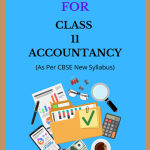NCERT Class 11 Accountancy MCQ Chapter 6 Trial Balance and Rectification of Errors Solutions, AHSEC Class 11 Accountancy Multiple Choice Question Answer to each chapter is provided in the list so that you can easily browse throughout different chapters NCERT Class 11 Accountancy MCQ Chapter 6 Trial Balance and Rectification of Errors Question Answer and select needs one.
NCERT Class 11 Accountancy MCQ Chapter 6 Trial Balance and Rectification of Errors
Also, you can read the SCERT book online in these sections NCERT Class 11 Accountancy Multiple Choice Solutions by Expert Teachers as per SCERT (CBSE) Book guidelines. AHSEC Class 11 Accountancy MCQ Solutions. These solutions are part of SCERT All Subject Solutions. Here we have given HS 1st Year Accountancy Objective Type Question Answer for All Subjects, You can practice these here.
Trial Balance and Rectification of Errors
Chapter: 6
| PART – Ⅰ |
MULTIPLE CHOICE QUESTION ANSWER
1. The basic principle of accounting states that for every debit, there will be an equal:
(i) Expense.
(ii) Asset.
(iii) Credit.
(iv) Liability.
Ans: (iii) Credit.
2. Which of the following is not verified by the trial balance?
(i) Arithmetic accuracy of ledger postings.
(ii) Errors in account balances.
(iii) Accuracy of cash transactions.
(iv) Final balance of all accounts.
Ans: (iii) Accuracy of cash transactions.
3. What is a trial balance?
(i) A statement of profit and loss.
(ii) A list showing the balances of all ledger accounts.
(iii) A summary of cash transactions.
(iv) A record of inventory levels.
Ans: (ii) A list showing the balances of all ledger accounts.
4. The main purpose of accounting is to:
(i) Record only cash transactions.
(ii) Track the number of employees in a company.
(iii) Provide financial information to stakeholders.
(iv) Advertise the company’s products.
Ans: (iii) Provide financial information to stakeholders.
5. In a trial balance, which of the following accounts is likely to have a credit balance?
(i) Cash in Hand.
(ii) Debtors.
(iii) Capital.
(iv) Carriage Inwards.
Ans: (iii) Capital.
6. What is the effect on the trial balance if a purchase of Rs.2,000 is omitted?
(i) The trial balance will show a surplus of Rs.2,000
(ii) The trial balance will show a deficit of Rs.2,000
(iii) The trial balance will balance
(iv) There will be no effect on the trial balance
Ans: (i) The trial balance will show a surplus of Rs.2,000.
7. Which of the following is the example of Capital Reserve?
(i) Workmen’s Compensation Fund.
(ii) None of these.
(iii) Premium Received on issue of shares or debentures.
(iv) General Reserve.
Ans: (iii) Premium Received on issue of shares or debentures.
8. Depreciation helps in determining ________.
(i) Increases the value of the asset.
(ii) Revenue generation.
(iii) Increase the burden of tax.
(iv) Accurate level of profit.
Ans: (iv) Accurate level of profit.
9. The totals method of preparing a trial balance is based on which accounting system?
(i) Single-entry system.
(ii) Cash-based system.
(iii) Double-entry system.
(iv) None of these.
Ans: (iii) Double-entry system.
10. Which method involves ascertaining the total of each side (debit and credit) in the ledger separately?
(i) Balances method.
(ii) Totals method.
(iii) Adjusted method.
(iv) Summary method.
Ans: (ii) Totals method.
11. Which method is most widely used for preparing a trial balance?
(i) Totals Method.
(ii) Balances Method.
(iii) Summary Method.
(iv) Adjusted Method.
Ans: (ii) Balances Method.
12. If a sale of goods amounting to Rs.5,000 is recorded as Rs.50,000, which type of error is this?
(i) Error of commission.
(ii) Error of principle.
(iii) Error of omission.
(iv) Error of duplication.
Ans: (i) Error of commission.
13. In the trial balance, the term “sundry creditors” replaces which of the following?
(i) Total liabilities.
(ii) Individual creditor accounts.
(iii) Account payables only.
(iv) Debtors.
Ans: (ii) Individual creditor accounts.
14. The method that combines both the Totals Method and Balances Method in trial balance preparation is called:
(i) Hybrid Method.
(ii) Combined Method.
(iii) Totals-cum-Balances Method.
(iv) Summation Method.
Ans: (iii) Totals-cum-Balances Method.
15. If a trial balance tallies, which of the following can be assumed?
(i) All transactions have been posted accurately.
(ii) There are no errors at all.
(iii) Total debits equal total credits.
(iv) Financial statements are ready to be prepared.
Ans: (iii) Total debits equal total credits.

Hi! my Name is Parimal Roy. I have completed my Bachelor’s degree in Philosophy (B.A.) from Silapathar General College. Currently, I am working as an HR Manager at Dev Library. It is a website that provides study materials for students from Class 3 to 12, including SCERT and NCERT notes. It also offers resources for BA, B.Com, B.Sc, and Computer Science, along with postgraduate notes. Besides study materials, the website has novels, eBooks, health and finance articles, biographies, quotes, and more.




